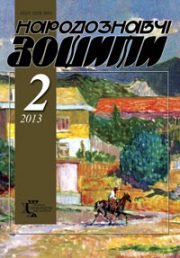The Ethnology Notebooks. 2024. № 4 (178), 926—935
UDK [75.071.1.04:27-526.62](477.83/.86)”18″
DOI https://doi.org/10.15407/nz2024.04.926
KOVAL Andriy
- ORCID ID: https://orcid.org/0000-0002-8009-1744
- Lviv National Academy of Arts,
- Lecturer of the graphic design department,
- 38, st. Kubiiovych, 79011, Lviv, Ukraine,
- Contacts: e-mail: koval.andr18@gmail.com
Abstract. The aim of this article is to represent the artistic contributions of the artist K. Ustiyanovych, related to the figures of Volodymyr the Great and Princess Olga. The end of the 19th century in Galicia is noted by the rise of national consciousness and self-identification of the nation. This period is characterized by a deep interest in the historical past, which was reflected in various spheres of cultural and social life, particularly in church art. The revival of church painting included the canonization and depiction of state and religious figures who contributed to the development of Ukrainian church heritage.
The object of this study includes preserved works of the artist that we have been able to identify. The artist Kornylo Ustyianovych made a significant contribution to the development of church art during this period. His works, based on historical sources and folk tales, were often characterized by detailed study and the integration of religious and national motifs. The artist created numerous monumental works in the churches of Galicia, where he depicted Prince Volodymyr and Princess Olga in various compositional arrangements and perspectives. His works were noted for their deep symbolism, versatility, and sophistication. As a poet, the writer also frequently turned to the princely era of Kyivan Rus, using folk legends and historical sources. His literary works include the poem «Sviatoslav the Brave» and the historical tragedy «Oleh Sviatoslavych of Ovruch,» dedicated to his father. Overall, Kornylo Ustiyanovych’s activity contributed to the rise of the national spirit and the strengthening of Ukrainian cultural identity. His paintings reflect a harmonious blend of historical, religious, and national motifs, which is a significant element in the context of the revival of the Ukrainian church and cultural heritage at the end of the 19th century.
A comparative analysis of various artistic iconographic interpretations of Saint Prince Volodymyr the Great is conducted in the article. Two main approaches to depicting Prince Volodymyr and Princess Olga are analyzed: symbolic and realistic. In the first case, the focus is on symbols that reflect historical and religious significance (the three-bar cross, the model of a church, etc.). In the second case, the depiction is more precise and realistic. Various aspects such as compositional, technological, and contextual are analyzed. This article highlights the diversity of interpretations of the iconic images of saints in visual perception.
Keywords: icon painting, church art, interpretation, Prince Volodymyr, Princess Olga.
Received 2.07.2024
REFERENCES
- Stankevych, M. (2006). Volodymyr the Great. Dictionary of Sacred Art (P. 60). Lviv [in Ukrainian].
- Stankevych, M. (2006). Olga the Saint. Dictionary of Sacred Art (P. 168). Lviv [in Ukrainian].
- Lviv National Scientific Library. Manuscript Department. Fund 93. Collection unit 110 [in Ukrainian].
- Shpak, O. (2006). Trebnyk. Dictionary of Ukrainian Sacred Art (P. 240). Lviv [Ukrainian].
- Margolina, I. (2016). Wrapped in the Veil of Oblivion. Paintings by Ukrainian Artists in the St. Cyril’s Church. Kyiv: Lybid [in Ukrainian].
- Lucyk, I.Ya. (2011). Lives of Saints, Whom the Ukrainian Greek Catholic Church Honors Every Day Throughout the Year. Lviv: Svichado [in Ukrainian].
- Ovsiichuk, V. (1996). Ukrainian Painting of the 10th—18th Centuries. Problems of Color. Lviv: Institute of Ethnology of the National Academy of Sciences of Ukraine [in Ukrainian].
- Semchyshyn-Huzner, O. (2019). Iconography of St. Josaphat Kuntsevych in Ukrainian Art of the First Half of the 20th Century. Sources of Inspiration. Ethnology notebooks, 6 (150), 1464—1481 [in Ukrainian].
- Marchak, V. (2018). About Painting. Lviv [in Ukrainian].
- Bokenska, Ye. (2002). Memories of Kornylo Ustiyanovych. Works (P. 80—89).Lviv: Kamenyar [in Ukrainian].





